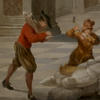Iconoclasts Anonymous: Why did it take Historians so long to identify the Image-breakers of 1566?
DOI:
https://doi.org/10.18352/bmgn-lchr.10184Keywords:
Iconoclastic Fury, Iconoclasm, History, Low Countries, BelgiumAbstract
This article asks why until the mid-twentieth century both Catholic and Protestant interpretations of the iconoclasm converged on the anonymising of the iconoclasts of 1566. It argues that, while a greater availability of sources, better source criticism and international debates helped eventually to give the iconoclasts a face, the main reason why it has took so long for the image-breakers to lose their anonymity was that it was in no one’s interest to identify the culprits.
For centuries, Protestants considered the iconoclasm an embarrassment, and preferred to dismiss its perpetrators as ‘rabble’, while Catholics in the Southern Netherlands tended to dismiss them as foreigers, manipulated by the nobility. Their anonymity was lifted through the intervention of German historian Erich Kuttner, whose main thesis was proven wrong, but at last triggered serious research into the identity of the iconoclasts, as well as alternative explanations of their motives.
This article is part of the special issue 'Beeldenstorm'.
‘Iconoclasts Anonymous’. Waarom duurde het zo lang voordat historici de beeldenstormers van 1566 identificeerden?
Dit artikel werpt de vraag op waarom zowel katholieke als protestantse geschiedschrijvers tot de tweede helft van de twintigste eeuw zo weinig belangstelling hadden voor de identiteit van de beeldenstormers van 1566. Hoewel bredere beschikbaarheid van bronnenmateriaal, betere bronnenkritiek en internationale debatten uiteindelijk hielpen om de beeldenstormers een gezicht te kunnen geven, betoogt dit artikel dat het eeuwenlang vooral in niemands belang was om de daders te identificeren.
Protestanten vonden de herinnering aan de Beeldenstorm erg pijnlijk en maakten daarom anoniem arm ‘gespuis’ tot zondebok, terwijl katholieken in de Zuidelijke Nederlanden ze het liefst wegzetten als de buitenlandse werktuigen van opstandige edellieden. Hun anonimiteit werd opgeheven door de interventie van de Duitse historicus Erich Kuttner, wiens interpretatie weliswaar niet houdbaar bleek, maar wiens werk wel de aanzet werd tot serieus onderzoek naar de beeldenbrekers, en alternatieve verklaringen voor hun motieven.
Dit artikel maakt deel uit van het themanummer 'Beeldenstorm'.
Downloads

Published
Issue
Section
License
Authors who publish with this journal agree to the following terms:
a) Authors retain copyright and grant the journal right of first publication with the work simultaneously licensed under a Creative Commons Attribution 4.0 International (CC BY 4.0) that allows others to share the work with an acknowledgement of the work's authorship and initial publication in this journal.
b) Authors are able to enter into separate, additional contractual arrangements for the non-exclusive distribution of the journal's published version of the work (e.g., post it to an institutional repository or publish it in a book), with an acknowledgement of its initial publication in this journal.
c) Authors are permitted to post their work online (e.g., in institutional repositories or on their website) prior to and during the submission process.
Authors are explicitly encouraged to deposit their published article in their institutional repository.







